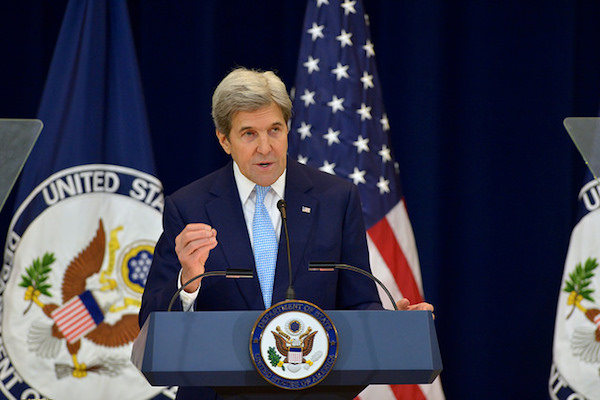Twenty years after the Palestinian leadership declared partition ‘entirely illegal,’ they reversed course and recognized that accepting the division of the homeland could lay the groundwork for an independent state.
By Jerome M. Segal

A few days ago, Israel and its supporters worldwide marked the 70th Anniversary of the 1947 Partition Resolution, which was passed by the UN and called for the division of Palestine into two states, one Arab and one Jewish.
Why did the Palestinians say “no” to partition? The answer is simple. They believed that it was unjust, that all of the land was rightfully theirs, and, more to the point, they believed they did not have to accept it. Everyone knew that war was imminent, and the Palestinian could not imagine that 600,000 Jews could withstand the overwhelming power of the Arab armies.
But in their celebrations, the commemorators missed a different anniversary. It occurred, largely unnoticed, two weeks earlier: the 29th anniversary of the Palestinian Declaration of Independence, proclaimed by the PLO on November 15, 1988.
Without familiarity with the Palestinian Declaration, however, the fuller story of the partition resolution cannot be understood. In their declaration, the Palestinians reversed their historic position on the partition resolution, as stated in the Palestinian National Covenant adopted in 1964:
The partition of Palestine in 1947 and the establishment of the state of Israel are entirely illegal, regardless of the passage of time, because they were contrary to the will of the Palestinian people and to their natural right in their homeland, and inconsistent with the principles embodied in the Charter of the United Nations; particularly the right to self-determination.
Interestingly, the covenant took a position on international law, claiming that partition was “illegal, regardless of the passage of time.” Then, almost to the day, some 41 years after partition was adopted in Flushing Meadows, the Palestinian Declaration of Independence made a quite different assertion. Still believing in the injustice of partition, a re-unified PLO that even included hardliners such as George Habash, reversed its stance on international law; rather than saying that partition was illegal, they acknowledged the legitimacy of the resolution. Noting that it provided for a Jewish state, they went on to invoke it as the basis in international law for a Palestinian state, writing:
Despite the historical injustice inflicted on the Palestinian Arab people following upon . . . U.N. General Assembly Resolution 181 (1947), which partitioned Palestine into two states, one Arab, one Jewish, yet it is this Resolution that still provides those conditions of international legitimacy that ensure the right of the Palestinian Arab people to sovereignty.
In those days, no one was demanding that the PLO revoke its position on the resolution. Indeed, Arafat’s legal advisors had provided him with a quite different draft of a Declaration of Independence — one that did not base the Palestinian state on the partition resolution at all, but solely on the Palestinian right to self-determination. This alternative did not tie the legitimacy of the Palestinian state- to-be to that of Israel. Arafat rejected this earlier draft, and turned to Palestinian national poet, Mahmoud Darwish, to pen the actual declaration.
Much of this is not well known, even to those who follow the conflict very closely. Some I learned only through research for my new book on the Palestinian declaration. It is, however, of great significance, as it makes clear that the Palestinians, at least in November of 1988, were not merely making a unilateral declaration — they were undertaking “unilateral peace-making,” balancing unilateral assertion with unilateral concession on the core issues of the conflict.
Last December, in Secretary of State John Kerry’s final speech on the conflict, the United States recognized the significance of the 1988 Declaration of Independence for the first time. Kerry proposed a new way to deal with Israel’s demand that the Palestinians recognize Israel as a Jewish state, stating that the parties commit themselves to negotiations which would “fulfill the vision of UN General Assembly Resolution 181 of two states for two peoples, one Jewish and one Arab,” adding that “both Israel and the PLO referenced Resolution 181 in their respective declarations of independence.”

Belated as it was, this appreciation of the Palestinian Declaration is of great importance, pointing the way toward a resolution of the Jewish state issue, and perhaps the conflict as a whole. The Palestinians are expected to soon renew their quest for membership in the United Nations, and when they do, they should make clear that the state seeking admission is the one proclaimed in their 1988 declaration, that is, a state based on the acknowledgement of the international legitimacy of a document that called for both an Arab state and a Jewish state. If they take this step, tying their legitimacy to that of Israel’s legitimacy as a Jewish state, then both Israel and the United States should support the admission of this Palestine to the United Nations.
Jerome M. Segal, a Research Scholar at the University of Maryland, has recently completed the manuscript for his next book: The Palestinian Olive Branch — the Palestinian Declaration of Independence and the Strategy of Unilateral Peace-making. He is also President of The Jewish Peace Lobby. You can find him on Twitter at @JeromeSegal.

